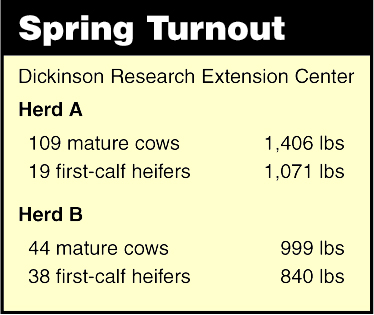



Sorting The Herd Out
Think before you jump because changes within a cow herd are hard to undo, By Kris Ringwall, Beef Specialist.In the northern Plains cattle business, late spring and summer are fun. No matter what type of beef operation, the shift to warmer weather is appreciated. Regardless of where a producer is at, spring and summer generally mean calving followed by breeding.
For the Dickinson Research Extension Centre, the spring calving season has been OK. The moisture is good, but not excessive, which is good for the grass and the pending cool-season crops. As usual, the warm-season crops are a flip of the coin right now, but we will see.
The cow sorts are finished and the bulls assigned to their respective cow groups. It was not business as usual at the centre this year. In fact, one could say driving over washed-out roads in an old pickup without shocks could be rather descriptive of the process. The centre made a fundamental change by establishing a smaller herd of cows.

The centre has slowly changed from maintaining a pool of cows that are assigned to various summer research projects to two different sets of cows that will be bred to maintain different body weights.
The larger set of cows (herd A) averaged 1,406 pounds as the animals were sorted for sending to spring pasture, and the smaller set of cows (herd B) averaged 999 pounds. For discussion, let’s say the cows averaged 1,400 and 1,000 pounds. In terms of the first-calf heifers, the future replacements for herd A averaged 1,071 pounds, while the first-calf heifers for herd B averaged 849 pounds.
Having completed the sorting, the pain of separating the cows and establishing the two herds is not evident just by looking at the numbers. Changing the basic makeup of a cow herd is a very slow process. The center has spent several years evaluating the steer counterparts within herd B (smaller cows) to make sure that the calves are marketable and will compete in the marketplace. They do.
Having established the preliminary value of the steers, the long road of evaluating the heifers and subsequent mother cows still is in progress. However, the step has been made. Herd A is more typical of northern Plains cattle. Herd B would be deemed, by most producers who look across the fence and comment, the smaller cattle. The obvious question from most producers, once they have realized and accepted the change, is “How did you do that?”
That is not a simple question. Perhaps a common misconception within the industry is that one can downsize with ease. That is true if one does not want to keep in mind that cattle need to produce red meat. Having spent some time in meat coolers, fat cattle with little meat do exist. If producers put pressure on downsizing the cow herd, they need to make sure they are producing calves that will grow into lean cattle with ample red meat and not fat cattle with little meat.
There are sources of genetics that will downsize cattle and meet the accomplished objective of producing red meat while the herd is in the feedlot or on grass. At the DREC, the initial downsizing involved the use of Lowline genetics to produce a half-blood Lowline cow from within herd A. The reason the process takes awhile is that only the replacement heifers were bred Lowline and these heifers were kept to establish herd B.
At the time of spring sorting, herd B consisted of 44 older cows and 38 first-calf heifers for a total of 82 head.
Herd A was reduced in numbers because the herd no longer functions as a pool for all the cow needs at the center. At spring sorting, herd A was at 109 mature cows and 19 first-calf heifers. An additional set of 24 cow-calf pairs were put on hold for sale in June. These cows averaged 1,515 pounds.
Now the fun begins because the center needs to find the right bulls to go with the cows. However, I will save that for next week.
For now, it simply is time to lean on the fence and look at those 24 cow-calf pairs. Gosh, they look good, and those calves at their side are huge.
As always, the bottom line is to think before you jump because changes within a cow herd are hard to undo.
June 2010


